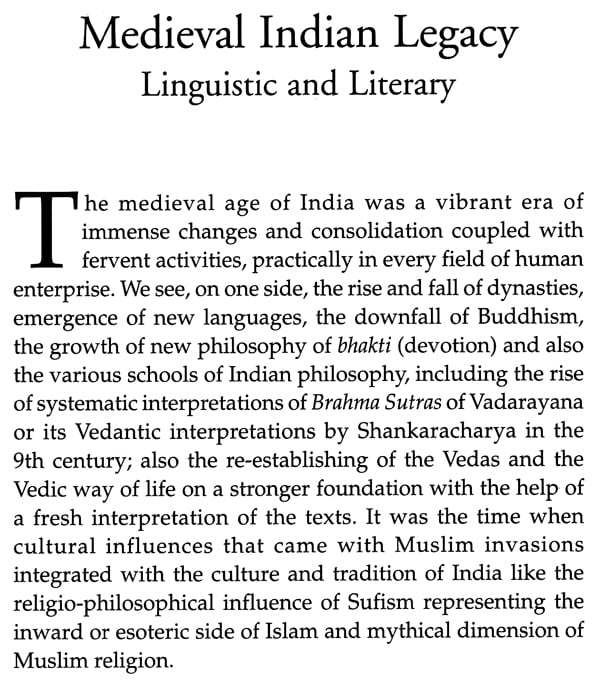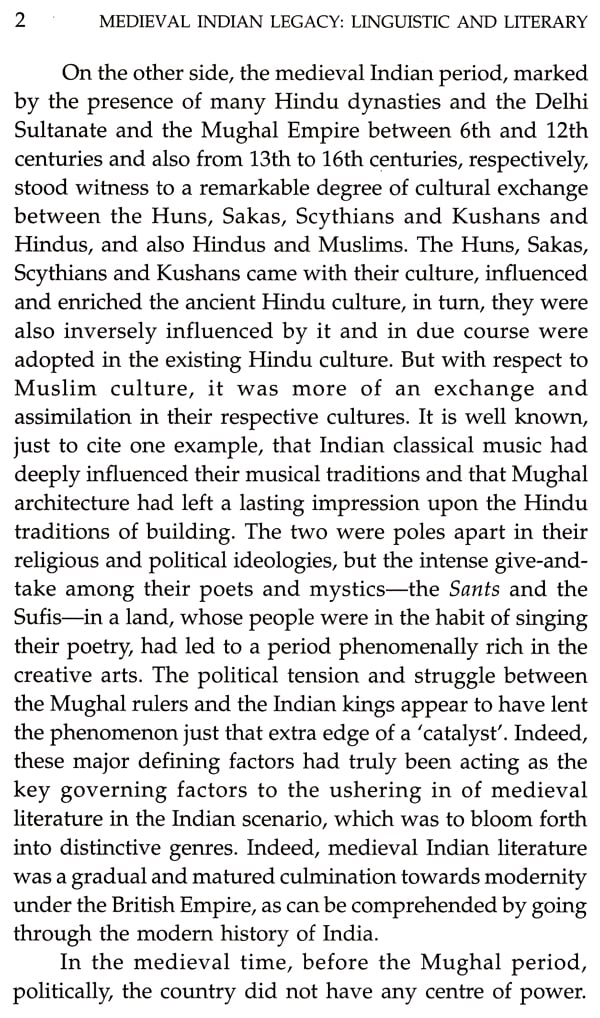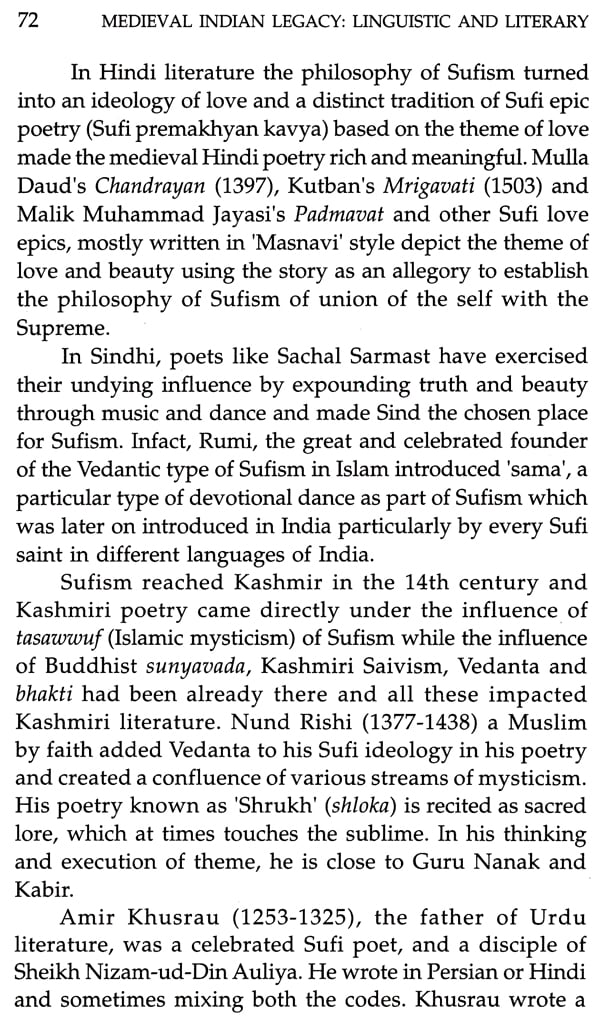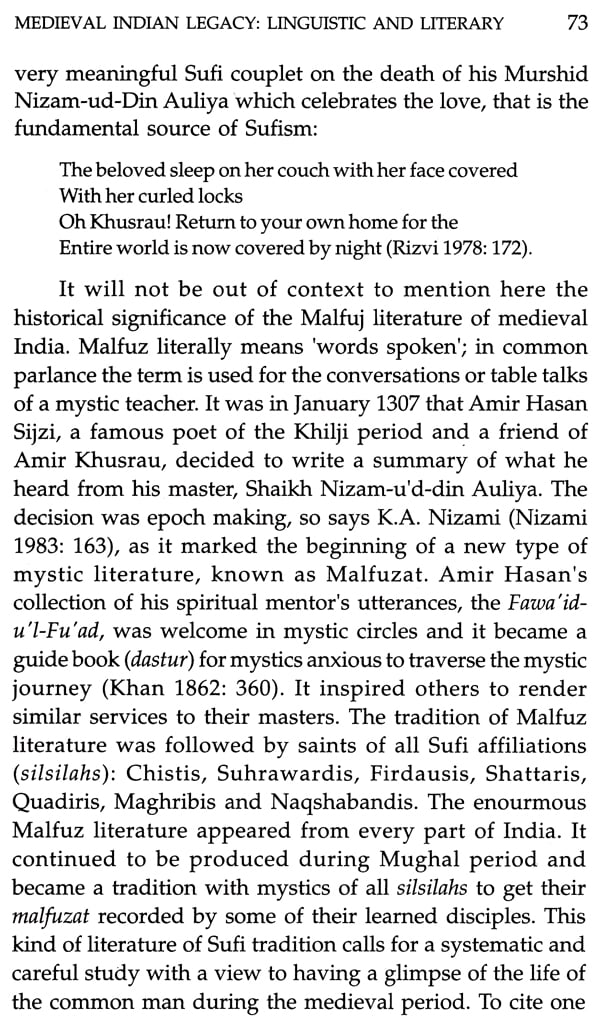
Medieval Indian Legacy (Linguistic and Literary)
Book Specification
| Item Code: | NAS728 |
| Author: | Indra Nath Choudhuri |
| Publisher: | Indira Gandhi National Centre for the Arts, New Delhi |
| Language: | ENGLISH |
| Edition: | 2012 |
| ISBN: | 9789380935607 |
| Pages: | 104 |
| Cover: | PAPERBACK |
| Other Details | 8.50 X 5.50 inch |
| Weight | 120 gm |
Book Description
Professor Indra Nath Choudhuri, an eminent academician, has been an administrator and cultural diplomat. He taught at Delhi University, Delhi, Uccha Siksha our Sodh Sansthan, Hyderabad and University of Bucharest (as an ICCR visiting Professor). He was visiting Professor in many other Universities including Central University, Hyderabad, and CIEFL, Hyderabad; Jadavpur University, West Bengal and JNU, Delhi. A distinguished cultural administrator, he was Secretary to Sahitya Akademi and Minister (Culture), Indian High Commission, London and Director, The Nehru Centre, London. He also served as Member Secretary and Academic Director, Indira Gandhi National Centre for the Arts, New Delhi. Prof. Choudhuri's areas of specialization include: Literature, Theory, Aesthetics, Dramaturgy, Religion, Cultural and Translation Studies. He has to his credit more than 50 research papers which include about a dozen papers on Tagore. Prof. Choudhuri has written books on Comparative Literature, Poetics and Aesthetics in Hindi, English and Bengali. His latest books include: The Genesis of Imagination: Selected Essays on Literature, Theory, Religion and Culture, 2001 (Sterling); Sparks Fly Upward: Three Essays on Aesthetics, 1999 (Temenos, London); Comparative Literature: Some Perspectives (in Hindi), 2006 (Vani Prakashan); Hinduism: A Way of Life and A Mode of Thought, 2012 (Niyogi) (written jointly with Professor Usha Choudhuri); The Reception of Tagore in North East India (ed.), 2012 (Institute of Development Studies, Kolkata).
Let me first express my gratitude to IGNCA for the invitation which they gave me to deliver the most prestigious Professor Suniti Kumar Chatterji Memorial Lecture, and now for publishing the lecture. What I came to know from the letter of Dr. V.S. Shukla of the Kalakoga Division that over the years these lectures were delivered mostly by well-known linguists like Professor S.K.Verma, Professor D.P. Pattanayak, Professor S.R. Banerjee, Professor Vidya Niwas Mishra and Professor Uday Narayan Singh. I am not a linguist but a comparatist and that might have prompted the authorities to invite me particularly when Professor Suniti Kumar Chatterji himself wrote a very seminal book on 'Languages and Literatures of India'. The topic of my presentation was one of my choice, 'The Medieval Indian Legacy: Linguistic and Literary'.
Let me state in this preface that Dr. Shukla's letter trapped me quite well, which mentioned, among other things, and I quote, "We are planning to print the proposed lecture in the form of a monograph." A monograph in Sahitya Akademi means a text of minimum 80 A4 pages and the result was that I prepared a text of a lecture of 80 to 85 pages, which could not have been presented within the time allotted to me. Thus, I made a summary of it and planned to present the shorter version of my lecture. The monograph is the original bigger version of the shorter lecture which I delivered at IGNCA on 6th May 2011.
I am grateful to Dr Kapila Vatsysyan for finding time to chair the lecture.
I had two little associations with Suniti babu. One, he was examiner of my Ph.D. thesis along with Pt. Hazari Prasad Dwivedi and Professor Devendra Nath Sharma.
Secondly, he was kind enough to accede to my request and write an introduction to my thesis when it was published in 1966 as A Comparative Study of Modern Bengali and Hindi Poetics.
Professor Chatterji was a great linguist and his book Origin and Development of Bengali Language (ODBL), first published in 1926, was priced Rs. 20, which, within a short time, became such a sought-after book that the old copies were resold for Rs. 500 till it was re-printed. He once accompanied Tagore on his tour to Singapore and Malay in 1927 and for one of his lectures Tagore said, "I am tired. This is the fourth lecture I am asked to deliver in one day and hence I shall ask my young friend S.K. Chatterji, who has accompanied me to this place, who is a great scholar known not only in India, but in Europe, and who has the strength of youth and much of wisdom, to speak on my behalf and that too in Hindi." Suniti babu's age that time was just 37.
I shall mention two more things about him. One, as President of Sahitya Akademi from 1969 to 1977, he was responsible in giving the Akademi's recognition to Maithili, Manipuri and Konkani languages. His idea was that each and every language has the potentiality to develop itself and our effort should be to encourage these languages. India always believed in the diversity of existence with many languages, cultures and religions and that gives India its vitality.
Secondly, the most important characteristic of his approach to linguistics was his emphasis on the pre-Aryan substratum in the Aryan speech. In his book Indo-Aryan and Hindi, he had proved that much of the literature of Sanskrit, particularly the Mahabharata and the Puranas, is based, nonetheless, on a translation substratum from the literatures of Indo-Aryan languages, which included the languages of born Aryans, mixed Aryans, non-Aryans and foreign speakers, who spoke Greek and old Persian. When Sanskrit attained pan-Indian prestigious position, its speakers became reluctant to disclose the translated character of its literary substratum.
I heard him speaking on Slavic Languages in Delhi University in 1969. I could never imagine that a purely linguistic topic dealing with foreign languages could be presented so interestingly. He had a sharp memory and gave innumerable references in his lecture which he remembered by heart.
Suniti babu once mentioned in his foreword to his book World Literature and Tagore that in his case as a professor of linguistics, which is generally considered a dry subject of study, he had the temerity to set forth his own views on literature. Similarly, I, being a comparatist, ventured to enter into an area which dealt with languages on which, though, the edifice of literature is created. I hope my readers may like to encourage me for plunging into an area, which is at least not unchartered for me.
I thank all my colleagues of IGNCA and its editor, Dr. Advaitavadini Kaul and also Shri V.B. Pyarelal, Joint Secretary for their help and cooperation in the publication of this monograph.
** Sample Pages**









